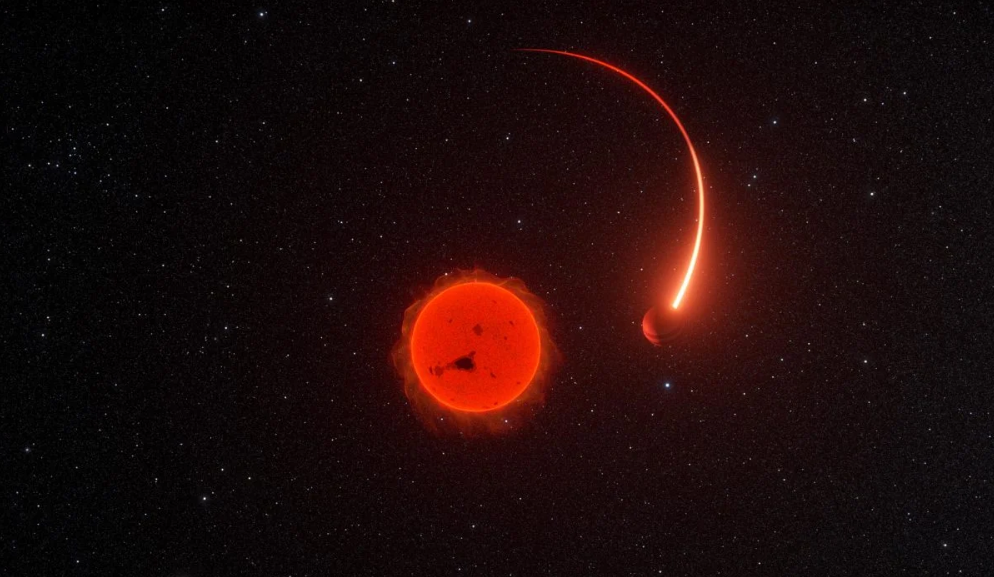
Astronomers used the NEID spectrograph and other instruments to verify its existence and successfully distinguished it from false binary phenomena, laying the foundation for future exoplanet exploration.
First, Gaia-4b is a "giant" among exoplanets. Gaia-4b has been confirmed to be one of the largest known exoplanets, orbiting a star with a relatively low mass. One of the key technologies for this discovery is the NEID spectrograph, which is installed on the WIYN 3.5-meter telescope at Kitt Peak National Observatory, which is supported by the National Science Foundation. Gaia-4b is also the first planet confirmed using astrometric technology used by the European Space Agency's Gaia spacecraft.
Second, NEID accurately detects the effects of planetary gravity. NEID is an extremely precise radial velocity spectrometer that can capture the tiny wobbles of a star caused by the gravity of a planet. This wobble causes a slight change in the position of the star in the sky, which scientists call the "radial velocity effect." NEID's core mission is to help confirm exoplanet candidates proposed by other projects. It is funded by NASA and the National Science Foundation (NSF) and operated by the WIYN telescope at Kitt Peak National Observatory, which has greatly promoted the exploration of distant planets.
Meanwhile, the unique contribution of the Gaia spacecraft. In addition to the support of NEID, the Gaia spacecraft has also played an important role in the discovery of exoplanets. Gaia advances our understanding of astrophysics by precisely measuring the position and motion of stars. Its technology - astrometry - reveals the existence of planets by analyzing the tiny motions of stars relative to the background. Unlike NEID, which detects planets through changes in the position of stars, the technology used by Gaia can capture the gravitational effects of planets through the motion characteristics of stars without directly observing planets.
Furthermore, screening planet candidates from "binary stars" to "real planets." With the release of Gaia data, scientists received a list of stars that contain suspected exoplanets. However, these candidate stars do not necessarily represent the existence of planets. In some cases, the stars are so close together that their motions look like they are caused by planets. To distinguish these possible false positives, scientists need further spectroscopic observations.
To do this, the team used NEID and two other spectrometers to follow up on 28 candidate star systems. This helped them distinguish 21 "binary" systems, where the stars actually move around a common center of mass. In addition, they found that one of the star systems has a brown dwarf, while the other contains a giant planet.
Finally, Gaia-4b is the hero behind the major discovery. Among this group of candidate star systems, Gaia-4b stands out. With an orbital period of 570 days and a mass of about 12 times that of Jupiter, it revolves around a star with a mass of 64% of that of the Sun. Not only is this planet the first confirmed by Gaia through astrometry, but it is also one of the largest planets known to orbit low-mass stars.
All in all, this is a moment full of excitement and anticipation for the NEID and Gaia teams. The Gaia spacecraft successfully detected a planet with its excellent astrometry technology, and NEID confirmed this discovery through its long-term precision measurements. This also provides a powerful verification tool for future exoplanets and brown dwarfs discovered by Gaia. As more data is released, more potential planet candidates are expected to be discovered and confirmed or denied by spectrometers such as NEID.

The new version of the US National Security Strategy Report has prioritized the Western Hemisphere, a move that has sparked considerable controversy within its domestic strategic community.
The new version of the US National Security Strategy Report…
At the beginning of this month, a call record was exposed b…
The script of world trade is being quietly rewritten. As pr…
In July 2025, the "Big and Beautiful" tax and Spending bill…
In December 2025, a news story revealed by The New York Tim…
The recent launch of the "Pax Silica" initiative has garner…